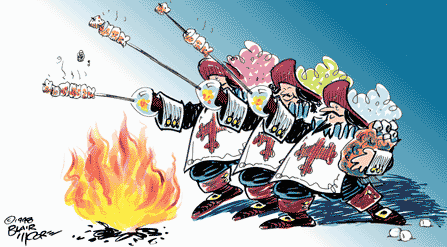| | MENU | |
-Main
-History
-Terms
-Equipment
-Journal
-Gallery
-Special Thanks
-Contacts
-Links


|
Fencing is dated back to about 3000 BC when whacking swords were used as the weapons. It's a form of defense and attack with a sword like weapon. Around 1200 BC, the Egyptians began the custom of fencing for sport, as seen by images in decorative relics from that period depicting knobs on the end of weapons, earflaps and other protective garb. During Medieval times knights used the sword as an offensive attack to crack armor or trust. In the 16th century the rapier was introduced in Italy bring the art of fencing into fencing schools. The non-sword arm was left free and held away from the sword arm to minimize the target area. The Italians, Spanish, and French all claim ancestry for modern fencing. In the 18th century, treatises appeared in print setting forth the current system of rules and scoring, and prescribing the foil, a metal mask with eye slit, and protective jacket or vest as equipment for use. The rules were intended to simulate real combat while protecting the safety of the combatants. Currently, Fencers wear a glove on the sword hand, a plastron (chest protector) or jacket, and a mask of wire netting. Three types of weapons are used in modern fencing: foil, épée, and saber. A bout or duel between competitors takes place on a specially marked out strip. The strip is 14 meters in length and 2 meters in width with one line at the center, lines two meters from either side of the center, and lines two meters from each end of the strip. The line two meters from the end of the strip is known as the on guard line. |

(Image ©John Blair Moore)
©2002 Holly Liu
All Rights Reserved